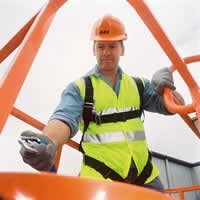Safety Procedures For Working On Heights

Most employment fields come with their own set of risks, but some are not for the faint of heart. Workers who perform tasks at great heights can face a number of potential dangers that others avoid by keeping their feet on the ground. There are a number of steps that you can take to ensure the safety of yourself and your coworkers when working at great heights.
Risk Assessment
The best way to avoid injury when working at heights is to remove as many risks as possible. While working at heights may never be completely safe, there are some steps you can take to assess and prepare for possible risks.
Check the conditions surrounding your work area. For outdoor areas, consult the local weather. High winds, rain and thunderstorms can create extremely hazardous situations for workers who are off of the ground, increasing the chance of falling, slippery surfaces or injury. Make sure your work area has proper overhead clearance from trees, power lines and other obstructions that could create damage or injury.
For indoor work areas, check the floor to make sure that it is level and stable. The area that will support your ladder or other height equipment should not be slippery or slanted, or else you risk your support falling out from under you.
Gather all of your equipment to your work area before you ascend. If you have to constantly climb up and down to your work area, you increase the risk of injury.
Surrounding Areas
Work areas that include workers elevated above the floor should be clearly marked and segregated to prevent people from walking or driving underneath. Falling debris or equipment can seriously injure anyone who may be below.
If possible, have a coworker or assistant on the ground below you to help you get down and to continue to assess risks and potential dangers. This worker should wear proper safety equipment, such as a hard hat, that will protect her from any falling objects.
Equipment Checks
Inspect all of your equipment before starting the job to ensure that everything is safe and in working order.
Ladders, lifts and scaffolds must be properly positioned and installed. Ladders must be properly extended and locked into place. Mechanical equipment should be properly connected and prepared, and users should review proper operating procedures before beginning the work.
Certain types of equipment, such as mechanical lifts, require safety equipment for proper use. All safety harnesses and lines must be secured and checked before work begins, in case of emergency. Workers should don all goggles, helmets, gloves and other safety equipment before ascending.
Finally, all tools and equipment that the worker needs should ascend with him. If using a ladder, attach tools to the belt or pouch that you wear as you climb. Taking your hands off of the ladder to grab equipment coming up from below can cause you to unbalance and fall.
Risk Assessment
The best way to avoid injury when working at heights is to remove as many risks as possible. While working at heights may never be completely safe, there are some steps you can take to assess and prepare for possible risks.
Check the conditions surrounding your work area. For outdoor areas, consult the local weather. High winds, rain and thunderstorms can create extremely hazardous situations for workers who are off of the ground, increasing the chance of falling, slippery surfaces or injury. Make sure your work area has proper overhead clearance from trees, power lines and other obstructions that could create damage or injury.
For indoor work areas, check the floor to make sure that it is level and stable. The area that will support your ladder or other height equipment should not be slippery or slanted, or else you risk your support falling out from under you.
Gather all of your equipment to your work area before you ascend. If you have to constantly climb up and down to your work area, you increase the risk of injury.
Surrounding Areas
Work areas that include workers elevated above the floor should be clearly marked and segregated to prevent people from walking or driving underneath. Falling debris or equipment can seriously injure anyone who may be below.
If possible, have a coworker or assistant on the ground below you to help you get down and to continue to assess risks and potential dangers. This worker should wear proper safety equipment, such as a hard hat, that will protect her from any falling objects.
Equipment Checks
Inspect all of your equipment before starting the job to ensure that everything is safe and in working order.
Ladders, lifts and scaffolds must be properly positioned and installed. Ladders must be properly extended and locked into place. Mechanical equipment should be properly connected and prepared, and users should review proper operating procedures before beginning the work.
Certain types of equipment, such as mechanical lifts, require safety equipment for proper use. All safety harnesses and lines must be secured and checked before work begins, in case of emergency. Workers should don all goggles, helmets, gloves and other safety equipment before ascending.
Finally, all tools and equipment that the worker needs should ascend with him. If using a ladder, attach tools to the belt or pouch that you wear as you climb. Taking your hands off of the ladder to grab equipment coming up from below can cause you to unbalance and fall.
- 8127bbe0d9f86512e9fbf0e84d2df77fa8.jpg
References
http://www.ehow.com/list_6798378_safety-procedures-working-heights.html
http://www.safety-procedures.com.au/images/workingsafeatheights.jpg